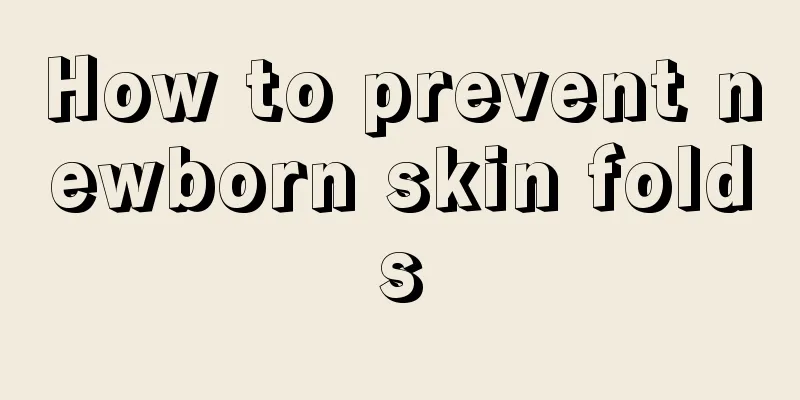What are the main symptoms of abnormal baby fontanelle? What should I do if my baby's fontanelle is small?

|
The fontanelle can reflect the baby's physical condition. So, what are the main manifestations of abnormal fontanelle in babies? What are the symptoms of abnormal fontanelle?1. Sunken fontanelle The main manifestation of a sunken fontanel is that the baby's front fontanel is sunken. Under normal circumstances, the baby's fontanel should be flat. Generally speaking, a sunken fontanel is caused by malnutrition due to lack of water or improper feeding. If you find that your baby's fontanel is sunken, you should replenish water and nutrition for the baby in time to ensure normal metabolism in the body. 2. Bulging fontanelle The symptoms of a bulging fontanel are the opposite of a sunken fontanel, which is a bulging fontanel that feels tight to the touch. If a baby's bulging fontanel is accompanied by symptoms such as fever and vomiting, and the bulge is more obvious when the baby cries, it is generally due to high intracranial pressure. Increased intracranial pressure is mostly due to intracranial infection, which may indicate that the baby has a disease such as meningitis. If the baby's anterior fontanelle changes and becomes more and more bulging, it may indicate that the baby has a tumor in the brain, or there is fluid or blood accumulation under the dura mater, etc. In addition, excessive administration of vitamin A, cod liver oil and other substances to the baby may also cause the baby's fontanelle to bulge. 3. Abnormal fontanelle size Abnormal fontanelle size usually manifests as an overly large fontanelle or a too small fontanelle. An overly large fontanelle means that the diameter of the anterior fontanelle reaches 4-5 cm shortly after the baby is born. An overly large fontanelle is generally caused by congenital hydrocephalus or congenital rickets. Babies with symptoms of an overly large fontanelle generally do not show it when they are just born, but the anterior fontanelle will gradually become larger a few days after birth. Babies with congenital rickets have larger anterior and posterior fontanelles, and the bone suture in the middle of the head is also wider. A small fontanelle means that the fontanelle is only as big as the tip of a finger, which may be caused by premature closure of the skull or microcephaly. Babies with small fontanelles should have their head circumference growth rate measured regularly and seek medical attention in time to understand whether their condition will affect the baby's brain development. 4. Abnormal closure of fontanelle Abnormal fontanelle closure refers to the baby's fontanelle closing too early or too late. Generally speaking, the latest closure of the baby's fontanelle is 18 months after the baby is born. If the fontanelle is still not closed after 18 months, it is called late closure of the fontanelle. If the baby's fontanelle closes late, you need to go to the hospital for further examination. Most babies' fontanelles close late due to rickets and cretinism. Under normal circumstances, the baby's fontanelle will gradually close after 6 months, but for babies whose fontanelles close too early, the anterior fontanelle may gradually shrink before 6 months, and some babies' fontanelles may even be as small as a fingertip. At this time, you should also go to the hospital for a check-up in time to see if the baby's fontanelle shrinks due to normal ossification or physical abnormality. If the baby's fontanelle is abnormal, it may indicate that the baby has physical abnormalities. Parents should check the growth rate of the baby's head circumference every month or every two months and compare it with babies of the same age to see if there is a significant lag. What to do if your baby's fontanelle is smallIf the baby's fontanelle is too small, the head circumference should be measured regularly to see if it is within the normal range before the baby is one month old. Parents should check the growth rate of the head circumference every month or every two months and compare it with normal babies to see if there is any obvious lag. If the baby's head circumference is developing normally, even if the fontanelle is a little smaller, it will not affect the development of the brain; if the head circumference is significantly lower than the normal value, you need to go to the hospital to check whether it is caused by disease. If the small fontanelle is caused by a disease, hospitalization is required; if it is not caused by a disease, but due to delayed bone development, then you need to follow the doctor's advice to supplement an appropriate amount of calcium to promote the growth and development of the skull. Fontanelle size standardThe size of the anterior fontanelle of newborns and infants varies from person to person, and the size is also different after birth. The average values of bregma size are presented here. The size of the baby's anterior fontanelle is 1.5~2 cm and diamond-shaped at birth; it reaches a maximum of 2.5~3 cm at about 6 months; and gradually ossifies and shrinks after 6-7 months. Normally, it will be completely closed at about 1 to 1.5 years old, and no later than 2 years old. If it closes too slowly or too early, the cause needs to be actively sought. Avoid diseases such as microcephaly or hydrocephalus. Tips: It is best for parents to measure the head circumference every 2 months and do a baby development check to see if the child's head circumference is growing at a normal rate and whether the overall development level is consistent with the age. If the head circumference is normal and the fontanelle closes early or late, the baby's health will not be affected. Otherwise, medical examination is needed. Daily care of fontanelle1. Do not use pillows that are too hard for your baby, such as mung bean pillows or sand pillows, otherwise it will easily cause the baby's head to deform. 2. Don’t let your baby sleep in a fixed position all the time. If you want your baby’s head to be perfectly shaped, you should often turn him over and change his sleeping position. Babies like light. If he is used to sleeping on one side, you can use light on the other side to attract him. 3. Pay attention to the furniture at home to avoid sharp corners that may hurt your baby's head. 4. If the baby accidentally scratches the scalp, it should be disinfected immediately with an alcohol cotton ball to prevent infection. 5. When going out in winter, you should wear a thicker hat to protect the fontanelle while reducing heat loss. |
<<: How to help your baby fall asleep on his own? Talk about infant sleep
Recommend
What should I do if my newborn keeps crying while sleeping? How long should I sleep?
I believe many parents have had the experience of...
What is the reason for the baby's cough in summer? What is the reason for the baby's cough in summer?
What is the reason for babies to cough in summer?...
What tests are needed before artificial insemination? When is artificial insemination?
Artificial insemination is the process of injecti...
What should parents do if their baby is always afraid of giving birth?
Babies need to pay attention to communication whe...
Can I drink red wine during pregnancy? Is it good to drink red wine during pregnancy?
Drinking a little red wine is actually good for t...
Why does the baby not grow tall? What should the baby eat if he does not grow tall?
There are many factors that affect a baby's h...
How to wear a baby jumpsuit? The benefits of wearing a jumpsuit for babies
Many parents like to wear onesies for their babie...
What are the common factors of infertility in modern women?
If you want to prepare for pregnancy, you must fi...
How long does it take for premature infant jaundice to subside? What is the normal value?
Jaundice is a common disease in babies, and prema...
What fruits are best for the fetus during pregnancy? What fruits are best for the fetus during pregnancy?
Usually, pregnant mothers pay much attention to d...
Why are the baby's leg lines asymmetrical? What are the growth and development standards for infants and young children?
Sometimes, carefully observing the baby's leg...
Is there any relationship between a baby's speech early or late and intelligence? What should I do if my baby speaks late?
Generally speaking, babies can speak some simple ...
What are the early childhood education courses?
Early childhood education institutions are emergi...
Things to note during early pregnancy:
There are many things to pay attention to in the ...
Typical symptoms of postpartum depression How long does it take to recover from postpartum depression
Many pregnant women will experience depression af...









